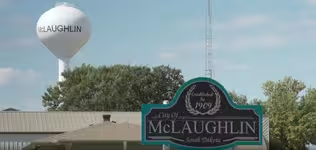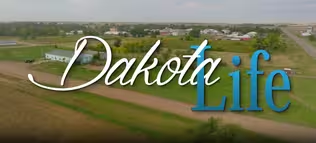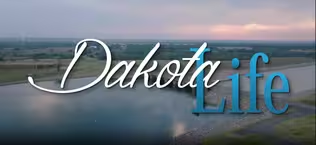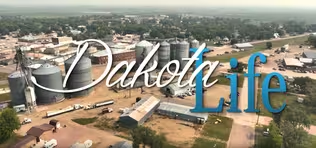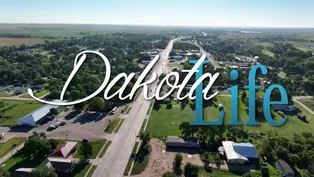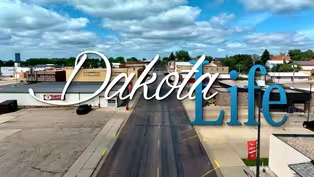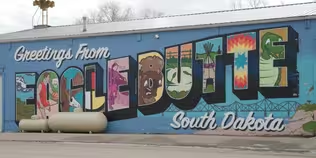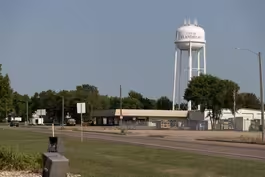Dakota Life
Greetings from Pine Ridge
Season 27 Episode 8 | 29m 45sVideo has Closed Captions
Greetings from Pine Ridge
We attended the 39th annual Oglala Nation Wacipi, the largest celebration of its kind in the state. We watched the Toby Classic at the skate park and learned why Pine Ridge is known as a basketball town. Additionally, we visited the Heritage Center to explore Indigenous art from around the world.
Problems playing video? | Closed Captioning Feedback
Problems playing video? | Closed Captioning Feedback
Dakota Life is a local public television program presented by SDPB
Support Dakota Life with a gift to the Friends of Public Broadcasting
Dakota Life
Greetings from Pine Ridge
Season 27 Episode 8 | 29m 45sVideo has Closed Captions
We attended the 39th annual Oglala Nation Wacipi, the largest celebration of its kind in the state. We watched the Toby Classic at the skate park and learned why Pine Ridge is known as a basketball town. Additionally, we visited the Heritage Center to explore Indigenous art from around the world.
Problems playing video? | Closed Captioning Feedback
How to Watch Dakota Life
Dakota Life is available to stream on pbs.org and the free PBS App, available on iPhone, Apple TV, Android TV, Android smartphones, Amazon Fire TV, Amazon Fire Tablet, Roku, Samsung Smart TV, and Vizio.
Providing Support for PBS.org
Learn Moreabout PBS online sponsorshipMore from This Collection
Dakota Life episodes featuring South Dakota's Native American Communities
Video has Closed Captions
In the heart of the Standing Rock Indian Reservation, we discover McLaughlin. (29m 29s)
Video has Closed Captions
Timber Lake celebrates its heritage in July with the Days of 1910 activities. (29m 41s)
Video has Closed Captions
Uplifting culture of the Dakota Oyate on the Crow Creek Reservation. (29m 17s)
Video has Closed Captions
From a window to the past to raising the next generation, Dakota Life explores Wagner. (28m 53s)
Video has Closed Captions
Dakota Life travels to the community of Mission. (29m 34s)
Video has Closed Captions
Dakota Life visits the community of Eagle Butte (26m 58s)
Providing Support for PBS.org
Learn Moreabout PBS online sponsorshipThis is a production of SDPB.
Our place of worship is, Grandmother Earth.
You sit out there the walls of where you pray is the trees, and, the buttes and, roof over your place of worship is the universe.
we're all two legged.
no matter where they're from, where two legged.
And so we have to start there that sometimes maybe.
Yeah, we pray differently.
We think differently sometimes.
Physically we, we kind of look different, you know skin color and stuff.
But what do we have?
Common ground is our emotions.
We can all, be sad, we can all be happy.
So sometimes we have to start there, Because our emotions are the language of the spirit.
Join our crew as we meet the people who are dancing, creating and winning in Pine Ridge.
Greetings from Pine Ridge.
Let's go Greetings from Pine Ridge.
Greetings from a wounded knee [Lakota Language] Greetings from Pine Ridge, home of the Toby Classic [Lakota phrase] Welcome to Thorpe Country USA.
[cheering] behind camera, "Perfect!"
Dakota Life.
Greetings from Pine Ridge is made possible with your membership in the friends of SDPB.
Thank you.
With help from the Badlands Express.
From Security First Bank providing mobile banking services to the Pine Ridge area since 1998, Security First Bank, where the bank member FDIC.
And by the Pine Ridge Chamber.
Spirit of the land.
Spirit of the people.
Pine Ridge, South Dakota, with vibrant Lakota art, historical sites and a living culture rooted in resilience.
Pine Ridge, where tradition and discovery meet.
Donors to the Explore South Dakota Fund.
Support the production of local documentaries and other programs of local interest.
Presented by SDPB Friends of SDPB Appreciates their support of this program.
We're here in beautiful Pine Ridge at the 39th Annual Oglala Lakota Nation Wacipi.
This annual celebration is bursting with both music and color.
It brings together dancers, drummers and singers from all over the country, not just to celebrate culture and heritage, but to laugh, love and eat some really good food.
Not to mention the opportunity to impress the judges and win prize money.
Whether foodie or photographer, it's a spectacle for the senses that draws tourists in by the thousands.
It's also an opportunity for those with wisdom to teach those without.
[loud speaker] "At this time, you may be seated in the audience.
So we're going to go into the introductions."
And for over four decades, one of those teachers has greeted audiences far and wide from the announcer's booth.
My Lakota name [Name in Lakota] And, I received that name at Sundance, and many years ago, I was a young and, I didn't have any idea that I would end up doing this.
I guess in English, you say master of ceremonies and a lot of different things.
Not only powwow, wacipi, ceremonies.
Births, deaths, lot of happy occasions that I do these.
But, ah, sometimes it's pretty sad, you know, but, I think the balance of everything in life, that's what, people call me to do for them.
And a lot of times, even our warriors, our military, the people that are in a service.
A long time ago, you couldn't stand up there and talk about your deeds.
They could look that as bragging so they would use a person like me, an eyapaha to speak for for them and, tell about their deeds.
It doesn't sound like they're, bragging.
You know, and our people understand the use of who we are as, people some call us, sometimes announcers or emcees, master of ceremonies.
But our real title is, in our society, is eyapaha.
went to power, and the eyapaha didn't show up.
And so the guys I sang with in a drum group said, hey, you speak good English."
"Oh, he will!"
You know, they volunteered me.
So I was and I think it was 1975.
My first powwow.
I must I did a good job.
They asked me to come back, For.
deeper ways of why we even dance at a pow wow.
Why do we even have the drum?
And why do we sit around a drum?
Why women come to sing with them, and all the even the, the audience that sits around in a circle, they're they're part of that circle culture.
Everything that we do is in a circle.
Compare it to, you know what?
Give us these houses with the corners.
when you clean, your house is the dirtiest part of your house in the corners.
Right?
So in our corners of our mind, all that negativity gathers.
So whenever we go to a pow wow or wacipi go to a circle and we participate and we start to really get into it, those corners break off.
And you go back to thinking in a circle.
Right.
So pattern how you connected with the spirit.
Your mind is clear because listening to good things.
You're seeing good things.
And you see people doing good things.
Among the many good things to take place over the weekend, like the rodeo, horse races, softball and volleyball tournaments, and an epic parade.
One of the most popular events is the Toby Classic.
Toby was like one of the pioneers of skateboarding within the community.
Skateboarding was an outlet for him.
Yeah, it was outlet for him.
He got out there.
He was.
He was free.
He could be his child.
He could not think about all those problems out there were just a thing that came from the heart he got out there.
He self-taught himself on a skate.
Toby's accident occurred during the 2003 Oglala Nation powwow, but he was out and about with his friends and more of what he thought all was well.
The power went good and everything and so I was informed that morning, like 5:00 in the morning, I rushed to the hospital.
Toby was already gone.
It was, one of the toughest days of our lives.
When he left.
While we were stationed overseas, you know, I knew he took up skateboarding with my younger brother and our cousin and he would reach out to me and said, Jean, let's get a skate park here.
And he goes, "I just want a place for our skaters to be, for us to skate, to have a safe place to skate."
Because here in Pine Ridge there was really nothing or where for them to skate at except for at the high school.
And so they skated up there and they called it "the bench."
So when he passed by, you know, I went to our, you know, on our family and I said, let's do the skateboard competition in his memory.
The first annual Toby Eagle skateboard competition is what we used to call it back in the day.
But it's actually, you know, bigger than that.
To where now it's the Toby Classic.
But that first day it was kind of unknown thing, right?
We relied heavily on the youth to tell us, you know, what what they wanted to see.
And our brother Little Larry, he skated then too.
And we had what, the first.
We had the best trick, I think.
And we had runs and we had it in the basketball court.
Then we thought we would just do it for one year.
And then, you know, I was like, we need to continue this because these kids, we saw how much it uplifts them, you know.
From sun up on that Saturday to sundown on that Saturday night.
I mean, we are here and we are wide open, from the skateboarders to the family to the sport.
We want to make this happen.
And then each year, we try to do our best to make it better than the year prior, two years ago.
So the 21st, we went to the first powwow, basically observed the Toby Classic, saw how much James got to do and how well it was run, and Larry doing the DJ work.
So I put it on my regular schedule.
Came back last year for the 22nd, and I think the minute Jeannie got here, she handed me something and 11:00 at night we went home.
And that was so I think I'm, booked for for the long haul now.
When I first start skateboarding, we had a young man that was killed up in the Wolf Creek community in an accident.
Skateboarding.
So I've always known about it, but I've always been concerned about it, too, that our young people be safe and everything, you know, and I know that was one of the things I saw the the kids wearing helmets.
Are they giving the helmets?
Things like that.
We've always been interested in what our youth are doing.
We have a lot of issues here on the reservation here, and, but we do have a lot of good things here.
And this is one of the real positive things that we have for our children.
It's something that it needs to continue, you know, on.
It represents a lot.
It gives you a lot of different feelings, like different emotions and everything.
Like and dislike and dislike what you are doing.
I can do certain things, but when you start trying and you start landing tricks and it makes you want to drive more and more and wants you to, you know, get better.
And I kind of for me, it kind of represents and reflects how you are as a person and what you're doing in life.
You know, we, you know, embrace Tubbies here because he reminds me a lot of Toby because they're like, oh, he's like a all around athlete.
So when I see those skateboarders out here, when I say I've never seen my brother skate, I'm watching my brother skate every year when I see these skaters, because it's so much joy, it brings them their smiles.
It's about community bringing us together and bringing awareness of, you know, how Toby passed away and just creating and being here till midnight, knowing that we kept them safe during Oglala Nation.
It's been a long journey, but in this unique situation, we were able to take a tragedy that was so deep and cut so hard, and we were able to transform it into something that has brought people together, has brought community together.
It's generational, like the powwow, like the rodeo.
Now, skateboarding is part of our Lakota culture and it's just a beautiful way of life we have.
A few miles north of the powwow grounds.
A different form of art is on display.
For over five decades, indigenous artists from across the country have been sending their work here to the Heritage Center at Mahpiya Luta.
For nearly six decades, the Heritage Center at Mahpiya Luta has been an avenue for art.
Indigenous artists from across the nation to submit their work to the center's summer art show.
This year was kind of crazy.
I mean, I don't feel like I advertised, as hard as I usually do in some past years, but we numbers wise, we had 206 pieces of artwork, to install this year.
That is not normal, but we usually have around 180.
170 is our comfort zone.
So it was a lot of being very strategic with how to hang the show.
This year.
And everybody went big.
There's a lot of big canvases, a lot of big pieces this year.
So it was a little hard to squeeze everything in here, but it also made the a really good challenge and made it really exciting to know that people are actually paying attention to this art show in the digital age.
More and more artists are exploring new ways to create their art, and you don't have to worry about just doing the classics of acrylic on canvas.
Like if you're more comfortable on an iPad or with whatever program software to create your artwork, then go for it.
I do want you to like, you know, experiment with actually getting it printed off into a hard copy.
I think that's always like, learning barriers for a lot of digital artists that work, in like, digital born a medium.
I think this year, the 56 and the art show, it was we were joking because usually there's always like a theme.
The past few years have been very stressful in society, and I know a lot of artists like to get their, feelings and emotions out, so.
But there really hasn't been a lot of hostility this calendar year, 2024.
So it's been a very tame, I think a kinder word we found, I found was like, nostalgically native where it's like it can be just be a reminder that art can be therapeutic and it can be healing.
Just to kind of get something, something out there and some type of expression.
And it doesn't always have to be social activist, or, intense commentary to get all the likes and views.
It can just be expression.
I think that's continuing.
Contemporary traditions really, that we have artists who've adapted from, say, traditional basket weaving design and done it in a two dimensional format with, with ribbon work.
Since ribbon work is now highly visible, it's popular.
We see it with digital art.
I'm waiting unless I've missed it in a recent year.
3D printing artworks.
I've seen that in other tribal museum, you know, gift shops or also in their permanent collections.
And those interpretations of how we use things that's going to keep evolving just as our language evolves.
So whether that's the English language, whether it's Lakota, the language constantly evolves.
So I think the artworks are evolving.
What, what and how mediums are used.
And so that's telling a story.
As its collection grows, the Heritage Center is gearing up for a big change.
The space is currently housed in Drexel Hall, a building constructed in 1888.
One of the oldest buildings in Pine Ridge, its new location just across the street.
There were a lot of planning meetings with a group of artists and community members to discuss and dream big.
And so while we didn't get everything that we would have hoped to get in this new design, we are thrilled that there was, in terms of a general facilities plan that we get to be first on that facility's long range plan, because the recognition was that we have a tremendous collection here and it is not an appropriate climate controlled storage.
You know, obviously, we know there's no fire department here, fire suppression system in the building.
There's not necessarily stable climate control.
And we've got such a diversity of collections between hard work, feather work, painting and textiles.
So that appropriate and stable collection storage is really exciting for us.
There's going to be conservation space to actually work in, to do some of the cleaning and repair and stabilization, maybe rebuilding some mounts and things like that.
Creating that easier access into collections is what really I'm really excited and looking forward to.
And not being such a, mystery.
So it's I think we'll have like, little windows to look into the collections as well.
When like we're not in there, it's probably just going to look very daunting.
But, yeah.
So I'm just really excited to welcome people into what we will have and what we can offer and how we're going to tell a story in this new space.
It will be somewhat limited, but in in the new design, part of what you would walk up to in the front looks like a half moon.
And I think within that space we're going to do more of an introduction as to how we define who we are in terms of, you know, the old oceti sakowin and that we're here in this community and that all the visitors that that we receive, I think we're around 14,000 visitors a year that, they learn a little bit more from creation story forward throughout our communities and wider western South Dakota to really, be that pillar of community that we want it to be and be more a destination of not just Lakota art, but also just a nice central Native American hub for anybody.
Awesome.
nestled amongst these hills.
While the Heritage Center has 50 years of imagery and enlightenment.
There are other types of history on Pine Ridge, from triumph to tragedy.
Dakotas called this place [Wounded Knee in Lakota] And that means a Wounded Knee.
Here is where, the massacre happened.
Behind me, you can see that, the US Army had a gatling gun pointed at our people, mostly women and children, you know, and, what was left of our warriors The Calvary had four Hotchkiss cannons.
All began firing rounds into the encampment between 250 and 350 Lakota men, women and children died In the aftermath of the massacre, an army inquiry exonerated the seventh cavalry.
Over 20 soldiers were awarded Medals of Honor for their part in the killings.
Over time, the truth has won out.
In 1990, both houses of Congress passed a resolution expressing, "deep regret" for the massacre.
Today, a monument marks this place And people learn about, remember and mourn the massacre to this day.
Yeah, I'm from here.
Yeah.
If you go up to the monument, you can see on, the monument is one of my ancestors.
One of my relatives name was, Red fish, and he was, he was a warrior, you know, I mean, that ended up dying, protecting the people here, if you really want to know what happened here, there's a book called Bury My Heart at Wounded Knee About 80 years after the massacre.
This became a site of protest and occupation.
The civil rights organization AIM, the American Indian Movement, occupied the nearby town of Wounded Knee.
They were protesting corruption within the local government, and also raising awareness about the challenges faced by Native Americans and the long history of federal mistreatment and broken treaties.
One of those treaties created the Pine Ridge Reservation.
The Fort Laramie Treaty of 1868 set aside a lot more land for the Lakota Nation, including the Black Hills.
Less than ten years later, in 1877.
The hills were seized by the US government after the discovery of gold.
This was an unconstitutional act.
Even the Supreme Court said so in 1980.
They ruled just that and awarded the tribes a multi-million dollar settlement standing together.
They have never accepted that payment.
Instead asking for the Black Hills to be returned.
While this can be a place of tragedy, It's also a place of strength.
In current day Pine Ridge, people are well acquainted with the troubles that continue to plague life on the reservation.
However, they also know the bright spots.
The neighbors you can count on.
The vibrant arts scene that adds color to everyday life.
The sense of community and culture rippling through the town and the reservation, plus the connection and championship that comes from athletics.
It's hard to talk about history without mentioning some of the sports icons in Pine Ridge.
Billy Mills won gold in the 10,000 meter run at the 1964 Olympic Games in Tokyo.
[Voice of Announcer over Loud Speaker] Look at Mills!
LOOK AT MILLS!
BILL MILLS WINS THE 10,000 METERS WHAT A TREMENDOUS SUPRISE HERE.
Bill Mills the United States Wins the 10,000 meters He was the first South Dakotan to receive a gold medal at the Olympics.
And then, of course, there's SuAnne Big Crow.
[Voice of Announcer over Loud Speaker ] AT THE BUZZER!
That's the ball game!
SuAnne Big Crow at the buzzer.
Pine Ridge wins it 42 - 40.
Despite passing away her senior year of high school, her legacy lives on today.
And while many sports and activities are offered in Pine Ridge, most will tell you basketball is king.
It's the game that kids grow up playing and falling in love with.
You know, we come from a warrior society, and this is one of our ways of being a warrior for the women and the work of men and women, you know?
So it's just a way to it's just a way to showcase yourself to your family and be a good warrior.
You know?
I think, with the city schools, we have enough talent for the three schools.
I, I really believe if we had two more high schools, we could fit two more basketball teams there, but that would be competitive.
You know, we have so many good, great athletes here.
Go Pine Ridge, we when I went to school here, we were a boarding school.
And we had nine different districts on the reservation.
We had representatives from all those districts coming to Pine Ridge to play here.
So Pine Ridge has always been the hub of, of basketball.
You know, back then we only had two high schools, Pine Ridge and Red Cloud, Holy Rosary.
Now we have six high schools, you know.
So we have our kids are spread out, you know, like, Pine Ridge.
It's always been the love of basketball.
Well, basketball to me is just everything.
Like, it's my whole life.
I've been doing it since I was itty bitty, my older siblings and older cousins have done it, so I've always been surrounded in the culture and literally being on the rez, coming to the games when I was little, when I was little, like, I've just been surrounded by basketball and it's always been something I loved.
So when I started to get good at it and I put in the work for it, and I just want to play basketball forever and as long as I can, well, like, we're all out here supporting our teams and like our people in our families and stuff, and like, it's just when the whole community gets out to come out and, you know, support the teams.
[cheering] We don't just cheer for one school.
You know, rivalries are rivalries, but, I guess I would say it's a good time to be together and see our students play basketball.
And when I'm, you know, cheerleading and just a good time to be together and see old friends.
And favorite part is, just being here at games, at our community, being at school with our kids every day.
It just makes my day because our enrollment enrollments back up since Covid, and and I'm just happy to be here.
Definitely the atmosphere, especially when I was growing up and the games and I actually come to it's always been packed with the fans.
And here the, the bleachers will always feel like, just see my seat, always be next to the person.
I was also just a young kid running around watching other greats that played here before.
It just playing.
You know, the Pine Ridge team won the the football playoffs and the conference.
They were saying that was a big thing.
But basketball was the game around here.
Everybody seems to play it through.
You know there's probably hoops in their houses.
They play there's one.
And in my where I played with my grandson.
And so it used to be it was just a Thorpe or Crusader.
But now they have Tech.
So it's kind of like it.
It's what they all want to play.
And it's just a big thing going on here to be Oglala Sioux you know, we're known for not being scared and frontline warriors you know being the first to battle you know and that's that's what we are.
That's where our strength comes from.
You know I mean I love my town.
I love this school.
You know, I don't want to be anywhere else, but Pine Ridge High School and I want to I want to teach young warriors to be young men, to use that not word, that name in a positive way.
Thank you for watching Dakota Life.
If you missed any of our stories or just want to go back and take another look.
Visit us at sdb.org/dakota life.
And before we call it a night, we have one more song.
The song I'm about to sing to you is called a Round Dance Song.
And it, brings a lot of people together in a good way.
And it gives me a chance to share my culture with a lot of others.
So, this is the song.
[Singing in Lakota] [Singing in English] Everything is good, everything is fine.
Every day is a good day.
With you by my side [Clapping behind camera] Thank you.
Thank you!
Support for PBS provided by:
Dakota Life is a local public television program presented by SDPB
Support Dakota Life with a gift to the Friends of Public Broadcasting
